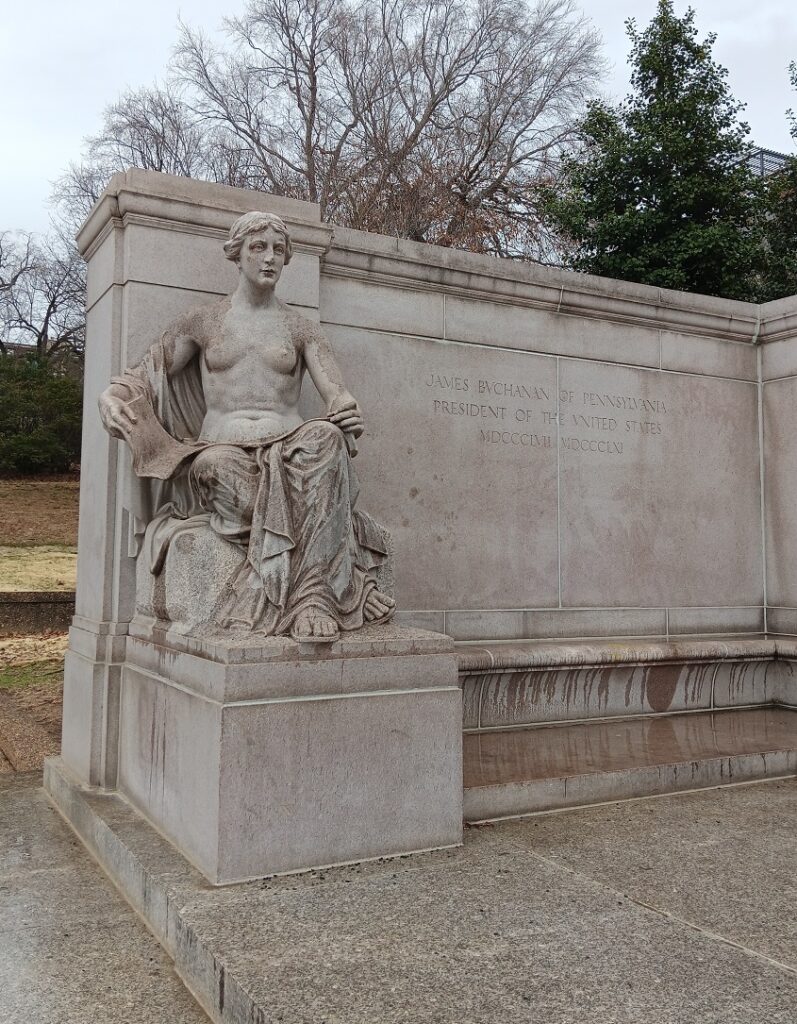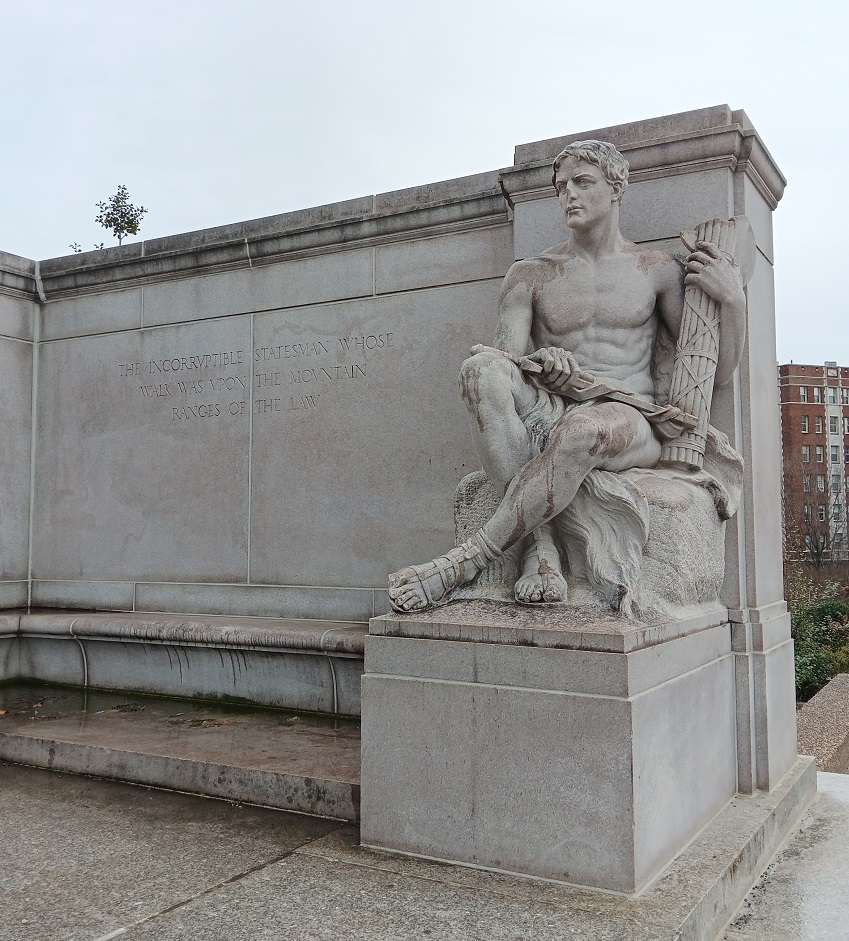Memorial: James Buchanan, served as President from 1857-1861
Sculpture: Hans Schuler
Architect: William Gordon Beecher
Dedication: June 26, 1930, 2:30pm
Ceremony: President Hoover addressed the crowd
Cost: $100,000 given by Mrs. Harriet Lane Johnston, Buchanan’s niece and hostess of the White House during his administration.
About Buchanan
Buchanan was born in Franklin County, Pa., on April 23, 1791, and died March 1867 at Wheatland in Pennsylvania. His public service career included being both a U.S. Representative and a Senator, serving as Minister to Russia, Secretary of State under Polk, and Minister to Great Britain under Pierce. His tenure as President is marked by strife in the Kansas Territory, the Dred Scott Supreme Court case, and the lead up to the Civil War.
During Buchanan’s service as President, his niece, Harriet Lane served as White House hostess. President Buchanan, who never married, was her uncle and guardian after she was orphaned at the age of eleven. When Harriet Lane Johnston died in 1903 her will included a bequest for a statue honoring her uncle.

Memorial Controversy
The controversy over erecting a memorial statue for James Buchanan in Meridian Hill Park began immediately. For 15 years Congress debated or ignored voting about the statue. The bequest had to be accepted by the United States by July 2, 1918 or the monies would revert to other purposes. And it took until 1918 for Congress to resolve to allow a statue in Buchanan’s honor, and then another 10 years to finish the memorial in Meridian Hill Park.
At issue was the question of Buchanan’s loyalty to the Union during his presidency, which immediately preceded Lincoln’s.
Leading the dissent was Senator Henry Cabot Lodge (R.,-Mass.) who stated, “This joint resolution proposes at this moment, in the midst of this war, to erect a statue to the only President upon whom rests the shadow of disloyalty in the great office to which he was elected.” Lodge also argued that was no excuse for erecting a statue to a man like Buchanan in the Capital City that at the time had no memorial to such Presidents as the John Adams, who signed the Declaration of Independence; Thomas Jefferson, founder of the Democratic Party, and Madison, Monroe and John Quincy Adams.
In the meantime the fine arts commission had approved the final model of the Buchanan memorial in 1916. So, on June 17, 1918 the Buchanan statue site was passed in the Senate by a vote of 51 to 11. The House of Representatives had passed a resolution for the statue on February 20, 1918 by a vote of 217 to 142.
The controversy continued for another 10 years with many citizens arguing against a memorial of any kind.
Memorial Dedication
The Buchanan Statue was unveiled on June 26, 1930.
President Hoover and a group of diplomats and government officials attended the unveiling and dedication.
The ceremony was not open to the public.
The formal presentation of the statue was made by Roland S. Morris, former ambassador to Japan. In his presentation Morris declared that over time, “[Buchanan’s] qualities as a statesman became apparent, and we now recognize him as one of our truly great men.”
Hoover, in his dedication speech, lauded Buchanan for his service and praised Harriot Lane Johnston for providing the funds for the memorial:
“His career was rich in achievements deserving the gratitude of his country. …It is due to Miss Lane’s devoted appreciation of his kindness that this statue has been erected, for she left provision for it in her will. This is, therefore an occasion not only honoring a great patriot but also testifying to a real filial affection.
Hoover concluded his speech by saying:
“I now dedicate the statue of James Buchanan, fifteenth President of the United States to the people of this country, for a memorial of his services as a man and as a Chief Office of Government.”
Upon unveiling the statue a dozen carrier pigeons were released from a lower pavilion, and the ceremony ended with the playing of “Taps”.
Buchanan was called the first of the log-cabin presidents that included Lincoln, Johnson, and Grant. Of these four, three have statues in the nation’s capital.


The James Buchanan Memorial is 32 feet long and made of marble. The statue of James Buchanan is made of bronze, and the marble behind the statue is inscribed with his name. Buchanan is shown seated, reading, and dressed formally in judicial robes.
The statue is flanked by two figures representing Law and Diplomacy.
One side is inscribed:
James Buchanan of Pennsylvania
President of the United States
MDCCCLVII – MDCCCLXI
The other side is inscribed with a quote from the Honorable Jeremiah S. Black who described Buchanan as:
The incorruptible statesman whose walk was upon the mountain ranges of the law
Photos by: Fiona Clem
References:
The Washington Post, Jun 18, 1918
The Washington Post, June 26, 1930
The Evening Star, June 26, 1930
The Washington Post, Buchanan Statue Site Authorized, June 18, 1918
The White House: http://www.whitehouse.gov/about/presidents/jamesbuchanan
